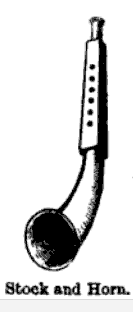Stock-and-horn

The stock-and-horn was a traditional instrument of the Scottish peasantry, very similar to the Welsh pibgorn, consisting of a single-reed reed pipe amplified by a bell made of horn. The original instrument of the Middle Ages had a double chanter with single reeds but was replaced by the single chanter type.[1] The single chanter instrument is described in great detail by Robert Burns in a 1794 letter to a contemporary; Burns describes how he had much difficulty coming by the instrument, and notes that it has six or seven fingerholes on the top, one on the back, and is played with a single reed ("oaten reed") unfixed to the instrument but held by the lips.[2]
See also
- Alboka, a similar Basque instrument
References
- ↑ Anthony Baines (1967). Woodwind Instruments and Their History. Courier Dover Publications. p. 223. ISBN 978-0-486-26885-9. Retrieved 10 March 2013.
- ↑ John Alexander Fuller-Maitland, Waldo Selden Pratt, Charles Newell Boyd, edited by Sir George Grove. Grove's dictionary of music and musicians, Volume 4. The Macmillan company, 1909. Pg 698
This article is issued from Wikipedia - version of the 10/16/2016. The text is available under the Creative Commons Attribution/Share Alike but additional terms may apply for the media files.